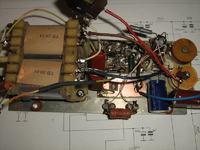Audioguru
Advanced Member level 7

- Joined
- Jan 19, 2008
- Messages
- 9,461
- Helped
- 2,152
- Reputation
- 4,304
- Reaction score
- 2,012
- Trophy points
- 1,393
- Location
- Toronto area of Canada
- Activity points
- 59,764
Hi Analy,
Many people built the project and it worked fine except it has a square-wave output, it does not have voltage regulation and it does not turn itself off when the battery charge becomes low.
1) Use a high capacity battery.
2) Measure the outputs of the CD4047 to see that there is a 50Hz or 60Hz square-wave with a peak voltage that is the supply voltage.
3) Measure the outputs of the LM358 opamps to see the square-wave with a peak of a few volts.
4) Measure the emitters of the 2SC1061 transistors and the transistors Q3 and Q4 to see the square-wave but with about 2.5V and 1.5V peak.
5) Measure the collectors of the output transistors to see the square-wave that is about 23V p-p.
Your schematic is old. A couple of changes make the circuit more reliable. See my modified schematic.
Many people built the project and it worked fine except it has a square-wave output, it does not have voltage regulation and it does not turn itself off when the battery charge becomes low.
1) Use a high capacity battery.
2) Measure the outputs of the CD4047 to see that there is a 50Hz or 60Hz square-wave with a peak voltage that is the supply voltage.
3) Measure the outputs of the LM358 opamps to see the square-wave with a peak of a few volts.
4) Measure the emitters of the 2SC1061 transistors and the transistors Q3 and Q4 to see the square-wave but with about 2.5V and 1.5V peak.
5) Measure the collectors of the output transistors to see the square-wave that is about 23V p-p.
Your schematic is old. A couple of changes make the circuit more reliable. See my modified schematic.








